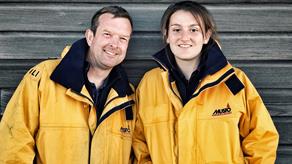The Lucy Lavers lives on
Aldeburgh lifeboat Lucy Lavers was among the 19 lifeboats that joined the fleet of ‘little ships’ in Operation Dynamo and her story continues to this day.
A boat built for beaches?
The Lucy Lavers is a ‘single screw’ Liverpool class lifeboat, which were much loved by crew around the coast in the 1930s and 1940s.
She was built in 1939 by perhaps the most famous lifeboat builders of the time, Groves and Gutteridge, on the Isle of Wight. With a light hull and draft of only 70cm, the Lucy Lavers was designed for carriage launch and was well-suited for working in shallow waters, close to beaches.
Arriving on service at Aldeburgh, Suffolk in 1940, she was about to have a first shout to remember.
On 30 May the Lucy Lavers was called upon to join a fleet of 700 private vessels making the 50-mile crossing of the English channel to the beaches of Dunkirk, where hundreds of thousands of soldiers found themselves stranded, the German army advancing.

Next story: Coxswain Ian Cannon’s great uncle Alf went to Dunkirk with the Ramsgate lifeboat crew. Ian’s daughter Becky is now part of the crew too.
Former coxswain of 27 years at Wells-next-the-Sea David Cox may have been a boy at the time, but he remembers the Lucy Lavers well – she served as relief boat for east coast stations when she retired from Aldeburgh after 19 years.
‘I was always told the Lucy never went on the beach because, if she had, they’d have had trouble trying to get her off,’ he says, explaining the design of the boat. ‘Consequently, she went alongside the big mole (breakwater) with all these troops on. She’d take them off the mole and onto the destroyer. She did a good job.’
‘I’ll always remember walking on the quay that night when they were all coming back, around about half-past-ten at night,’ David recalls. ‘There were a lot of people on the quay that night. The whole crowd started to sing: “For he’s a jolly good fellow”.’
‘When you think, you know, all those troops they got off. We didn’t have a clue what happened, in England.’
A new lease of life
After many good years of service to the RNLI, the Lucy Lavers was fully retired in 1968, when she became a pilot boat on the Channel Islands. But her story doesn’t end there.
Boat builder and lifeboat restorer David Hewitt of Rescue Wooden Boats had picked up a scent. ‘I’d heard about the ‘lucky Lucy Lavers' and had to find her,’ he enthuses.
Continuing: ’I kept making enquiries and getting nowhere. In the end we tracked her down to a place called Marchwood, near Southampton. It’s a boatyard alongside a military establishment. They told us that she’d been burnt and that was the end of the line.’
Burning a lifeboat is sacrilege to someone like David. But a couple of years later, he noticed in the Lifeboat Enthusiasts' Society handbook that this may not have been the end of her story after all!
‘The Dunkirk Little Ships Association had managed to grab hold of her right at the last minute before she was burned!' he says. 'They said she’d been allocated to a boat-building college down on the south coast somewhere. Another year went by and we got an email asking if we’d like to have her. So we bought her for £1.
‘It’s amazing she survived and it all came about through old fishermen talking about it. Lovingly and expertly restored over the next 2–3 years, the Lucy Lavers is looking better than ever. She returned to the water – crossing with the remaining fleet to Dunkirk – in 2015 for the 75th anniversary of Operation Dynamo.'
Lucy Lavers now resides in Wells-next-the-Sea, Norfolk, where people can visit her and enjoy trips on what is a lasting piece of the RNLI’s history and a testament to the enduring courage of our volunteer crews.





